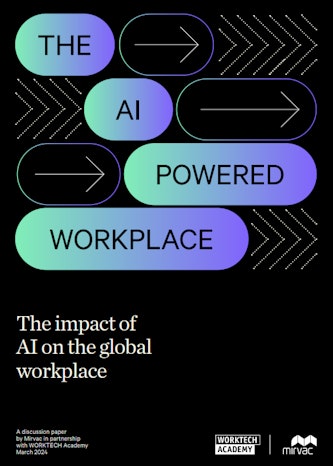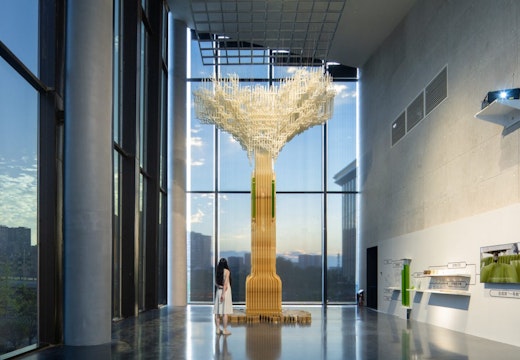Why company leaders should embrace the AI powered workplace
Employees rather than organisations have led on the use of AI in the workplace up until now. A new report from Mirvac says it’s time for company managers to create momentum
Amid the current explosion of interest and innovation in artificial intelligence (AI), there is clear potential for organisational leaders to apply this emerging technology to address a wide range of workplace challenges.
However, it has been employees rather than company bosses who have largely led the clamour for an AI-driven workplace. The launch of generative AI tools in the last year has generated intense public interest, and employees are now utilising AI tools as part of their day-to-day working lives.
But what if company leaders could directly apply the potential of AI to the future of the workplace? That is the focus of a new report from Australian developer Mirvac in partnership with WORKTECH Academy, entitled ‘The AI Powered Workplace’.

Three key areas
This discussion paper identifies three key workplace areas that AI is poised to transform: design, management and experience. In each of these areas, embracing AI tools will have a meaningful impact on how workplace teams can operate, says the Mirvac report.
Within the design sphere, AI has the power to provide a greater depth of information on space usage and employee needs, helping to develop workplaces that better meet the requirements of employees and offering a better workplace experience. For architects, there are also innovative uses of AI for ideation and for creating and assessing floorplate plans.
Mirvac’s Chief Asset Management Officer, Victoria Tavendale, explains that both designers and tenants currently lack data-driven insights to shape the design of office spaces.
‘AI’s data collection and integration capabilities can give us a much greater depth of knowledge around how spaces are used, to develop a more informed view of office space thus enabling us to deliver tailored and adaptable design solutions for our customers, as well as future recommendations on elements such as sustainability and employee experience,’ says Tavendale. ‘This process will deliver greater efficiency and long-term value for both landlord and tenant.’
Data-driven insights
For building management, there is a range of incoming uses for AI, from optimising resources and boosting sustainability to improving building resilience. Tavendale acknowledges how significant the power of enhanced data collection could be for the workplace: ‘At Mirvac we recognise the importance of building and workplace data, how it can be utilised, how it is shared, and how it will be key to unlocking the power of AI to enhance and evolve the property sector.’
The utilisation of data is a current pain-point for many organisations who have increased their use of sensors and are now ‘drowning in data’ that is difficult to integrate and action. Utilising AI to integrate data sets and answer questions about building utilisation could streamline this process, helping companies make cost and energy savings.
Learning from behaviour
When it comes to workplace experience, AI has the ability to learn from people’s behaviour and streamline the workflow for them. Mirvac’s Manager of Strategy and Customer, Elly Dalziel suggests that creating a frictionless connection to AI for employees will be key to improving workplace experience.
‘Employees will want to walk in the door and have an instant tech connection that creates a productive experience by making recommendations on the best room to use for virtual and in-person meetings, and suggesting where they should sit given the capacity of the workplace,’ explains Dalziel.
‘The next step is using AI to pre-empt behaviour, such as pre booking your wellness class based on a gap in your calendar, ordering your coffee and booking your end-of-trip facilities locker before you even jump on your bicycle. This would create immense efficiencies, a heightened workplace experience and ultimately help drive office attendance.’
Practical steps to take
The paper not only draws attention to the widening gap between employee use of generative AI and official use by large organisations but also concludes with some practical steps companies can take to prepare themselves for the AI revolution. These include:
- Re-evaluate your space and success metrics. The focus of metrics should be on the experience and level of employee engagement with the spaces (e.g. using sensors) rather than desk or meeting room utilisation.
- Start having conversations around data sharing. Companies can drive greater value from their space when both the tenant and landlord are able to share insights.
- Establish what datasets you have and where you can create value. The true advantage of AI in building management is in the ability to integrate multiple datasets, so companies need to establish what data they have and where it is comes from to be able to understand where they can gain advantage from these new tools.
- Educate leaders. It is critical that senior managers have a certain level of digital maturity to make informed decisions on company policies around technology and data to drive better decisions. Companies should evaluate their level of in-house knowledge and start educating their senior leadership to achieve this.
- Empower staff to engage with technology and understand the benefits. To get the full advantage of AI, everyone needs to be on board so robust change management practices are needed to ensure that no-one is left behind.
- Embed flexibility into design. Companies should look to embed flexibility early when considering workplace design and strategy. Instead of designing with a one-size-fits-all approach, consider designing in a kit-of-parts that can respond to suit the changing needs of the business, teams, technologies and environment, to enable adaptation when AI matures.
To find out more about the future of AI in the workplace, access the full Mirvac report ‘The AI Powered Workplace: The Impact of AI on the Global Workplace’ here or read an excerpt from the report in the Innovation Zone here.








